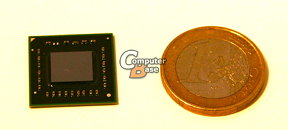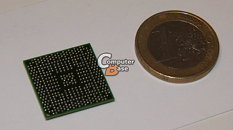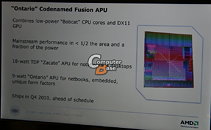Friday, September 3rd 2010

AMD's Fusion ''Ontario'' APU Chip Pictured
At the ongoing IFA event in Berlin, AMD displayed one of the first derivatives of its Bobcat low-power x86 processor architecture, codenamed "Ontario". This Fusion APU (accelerated processing unit), which is a combination of an x86 CPU and a DirectX 11 compliant GPU is built for low-power devices such as netbooks, handhelds, and tablets. AMD also showed off the chip package itself, which is roughly the size of a 1 Euro coin. The package, like AMD's mobile Athlon/Phenom processors, has no integrated heatspreader (IHS), but like the Intel Atom, uses a ball-grid array (BGA) to permanently fix itself to the system board.
AMD claims that the chip offers "mainstream performance" at less than half the die area (in this case, below 100 mm²), and a fraction of the power. Speaking of which, the "Ontario" Fusion APU has a TDP of 9W, while a higher-performance APU codenamed "Zacate", which is probably competitive with Intel's CULV processors, and is built for ultra-thin notebooks, nettops and slim all-in-one PCs, has a TDP of 18W. AMD claims that the two will ship (to OEMs, because these are not end-user products) in Q4 2010. For the desktop, AMD is developing the "Llano" Fusion APUs that are of a different form-factor and package altogether.
Source:
Computerbase.de
AMD claims that the chip offers "mainstream performance" at less than half the die area (in this case, below 100 mm²), and a fraction of the power. Speaking of which, the "Ontario" Fusion APU has a TDP of 9W, while a higher-performance APU codenamed "Zacate", which is probably competitive with Intel's CULV processors, and is built for ultra-thin notebooks, nettops and slim all-in-one PCs, has a TDP of 18W. AMD claims that the two will ship (to OEMs, because these are not end-user products) in Q4 2010. For the desktop, AMD is developing the "Llano" Fusion APUs that are of a different form-factor and package altogether.



38 Comments on AMD's Fusion ''Ontario'' APU Chip Pictured
OT: "Ontario"? Why not name the other chip "Erie" or "Quebec"? :laugh:
I compare it to ion since ion is the only netbook config that has acceptable performance. But it's not gonna surprise me one bit if this new "ontario" by AMD sets the bar a decent bit higher.
is this a single or dual-core chip?
[INDENT]AMD itself recently confirmed that Ontario -- which features two x86 cores based on Bobcat micro-architecture, integrated DirectX 11-class graphics core and DDR3 memory controller -- is actually a single-chip system-on-chip (SoC) device.
www.xbitlabs.com/news/cpu/display/20100420225440_AMD_Ontario_Monolithic_System_on_Chip_40nm_Fabrication_Process.html[/INDENT]
Preliminary performance numbers look good compared to the Atom D510.
die shot comparison of Bobcat vs Atom
More information in the thread
Best part of the Hardware-Info article:
the Mobility Radeon HD 5430 which as 80sp's @ 550MHz is rated around 7 watt... so really I'm not sure whether they will be able to pull a rabbit out of the hat on this one. having said that I believe 7w does include it's onboard memory .
This is for netbook/ultra portable and some very entry level desktop. Basically where ever Atom is at Bobcat is going to be AMD's offer.
This is like taking a dual core Wolfdale with a 5350 and putting it in a netbook and only having 18W for both parts max. It has the possibility of being so bad that it is rumored that Intel is getting a Sandy Bridge variant ready just in case. That alone should give a clear sign of what Intel thinks of not only Bobcat but also Atom. Problem with that is the SB part will be expensive, Bobcat shouldn't.
At the screen resolution the netbooks usually have, this gpu fairly good.
Ontario, welcome :banghead::rockout:
I think they said 32 nm for fusion, but i may be right, that would be the answer you would look for.
But more complex stuff. explaining benefits of fusion.
Okey, Leets do this example:
1
you got 1 volt.
over a 0,5mm^2 cable, over 3 meeters for instance, its not 1 v, current is lost because of the resistance in the cable.
you would maybe have 0,8volt and wudnt be suffecient to drive the chip.
So you gotta juice on 1 watt more, 1 watt here one watt there.
2.\ you got only one power circuit.
How much does theese thing use? well, quite alot of power, they do need cooling, the things next to your cpu, on low end they do not require this. meaning, a few watts shaved off there.
sharing memory controller for vga and cpu ?(uncertant) a few watts there too.
Stack up all the benefits here, and you'll see serious power figures(performance) and power consumtion go down.
Go back in history, amd going with IMC(interigated memory controller) then intel did, then intel just placed a IGP next to the cpu, and look what that did!
Big benefits, this is explained very.. non detailed whatso ever, but both intel and amd know, more in one chip benefits everyone, gpu's are too power hungry to be built in(for us.)
but a gpu doing opencl would be good!